Aug 2016
Seal pup Babs makes a cameo appearance at Alki
Aug/28/16 06:59 PM
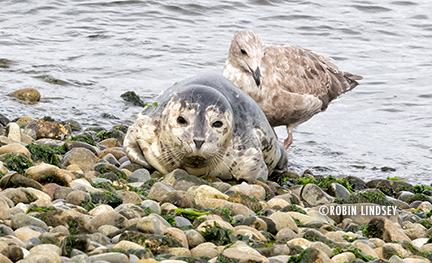
While establishing a perimeter to ensure the pup could rest undisturbed, a call was placed to the day’s volunteer scheduler, who promptly began lining up volunteers for what could potentially be a long day ahead.
The white pup with gray spots was not alone at the water’s edge, however. A seagull was intent on harassment, relentlessly pecking away at the pup’s rear end. After only about an hour and a half, the annoyed pup, nicknamed Babs, swam off in search of a quieter location to rest - one without a pesky seagull!
Seal Sitters new volunteer training a success
Aug/28/16 08:16 AM
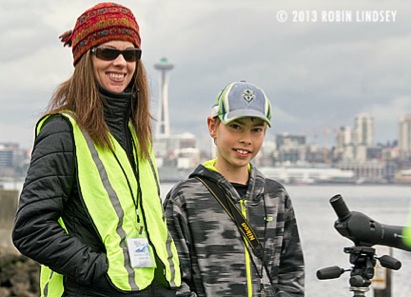
Unlike most marine mammal stranding networks, we encourage children to participate in Seal Sitters - supervised at all times, of course, by a parent or guardian. We are proud of our dedicated volunteers who are on duty rain or shine - we hope you, too, will join us!
For questions OR to be placed on a contact list for future Seal Sitters training opportunities, please email us. Seal Sitters MMSN does not hold trainings during the height of our pupping season late August - October due to time constraints on volunteers responding to marine mammals. If you live out of the West Seattle area and would like to find a stranding network closer to where you live, click here.
Seal pup repeatedly harrassed while trying to rest
Aug/13/16 12:00 PM
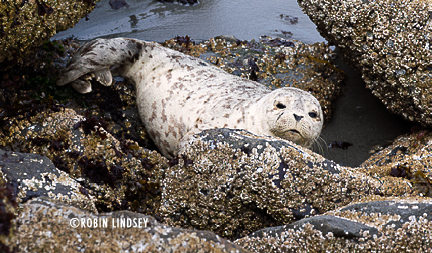
On Friday, the hotline received a call that someone was repeatedly “poking” a harbor seal pup on the beach. Our first responder was on the scene in record time, but both the seal and offender were gone. The seal did not return.
Photos of a seal pup resting at the same location were taken and posted the following Tuesday evening on the West Seattle Blog. The photographer commented that he had to warn people to leave the pup alone. Unfortunately, no one called the Seal Sitters’ hotline that day to ensure the pup’s safety.
SSMMSN’s first responders were out early on Wednesday morning, checking the beach to see if the seal might be onshore. The sand was empty, but they could see a glossy little head about 100 yards out from the pier, where the pup appeared to be foraging. The pup came ashore around 10am, nestling in the barnacle covered rocks below the sea wall (photo above). Access to the small pocket beach was promptly closed off with tape and informational signage that seals are protected by Federal law from harassment and harm.
Seal Sitters volunteers worked in shifts to answer questions from the public, educating hundreds about seal pups’ urgent need for rest against just 50% odds of survival their first year. The pup, nicknamed Seamor by a young volunteer, snoozed for many hours in the warm sun. As evening approached, the incoming tide and a large series of waves from a passing ferry headed for Bainbridge Island, swept over Seamor and the pup reluctantly headed out into the Sound.
Someone mentioned witnessing a person “lying on top” of the pup the day before. When the person finally got up and off, the frightened seal escaped into the water.
If you witness a marine mammal illegally being harassed, please take a photo to document the incident (do not put yourself at risk!) and contact NOAA’s Office of Law Enforcement @ 1-800-853-1964. In West Seattle, please call Seal Sitters, a member of NOAA’s West Coast Marine Mammal Stranding Network, first so we can get on the scene.
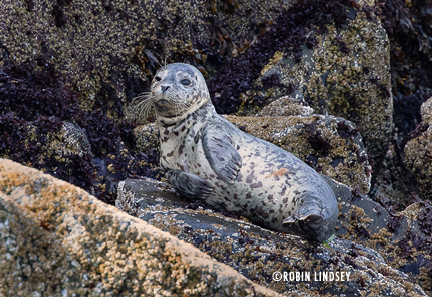
Somehow, though all the human chaos, Seamor did manage to get some sleep and rested under the watchful eye of Seal Sitters and rapt onlookers who peered into the spotting scope, allowing a closeup view of the white-coated pup. Around 9pm on this stunning evening, as the sun dropped behind the silhouette of the Olympic Mountains, Seamor finally flopped across the beach and disappeared into waves.
On Friday, expecting the pup’s return to that northernmost point of West Seattle, volunteers stood by. However, the area was busy with people walking and standing along the sea wall and there was very little beach to rest upon. We sighted a seal head glimmering offshore. Then, to our surprise, Seamor hauled out over 1/2 mile around the bend. Volunteers once again protected the beautiful little pup who snoozed until after 9pm. After waiting about 20 minutes to make sure there was no return trip to shore, tired volunteers gathered up stranding materials and finally went home to eat a very late dinner.
Seamor seems to be a pretty healthy pup, estimated to be about 4 weeks old and recently weaned. Wet rings around the eyes indicated that the pup is well-hydrated. The health of a pup can quickly take a downturn if not allowed to rest. Please make sure to call Seal Sitters hotline @ 206-905-SEAL (7325) promptly if you see a seal pup - or any marine mammal - onshore.
Humpback whale strands and dies on West Seattle beach
Aug/08/16 06:21 PM
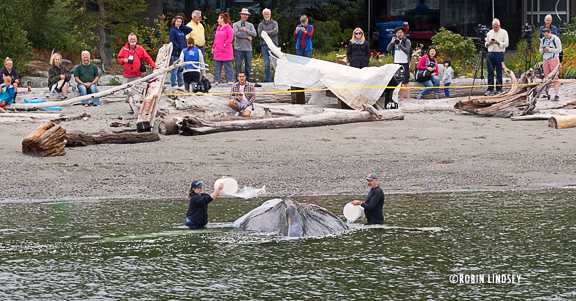
The last thing Seal Sitters MMSN (SSMMSN) hotline operator Kristen and First Responder Robin were anticipating early Sunday morning was a call about a “distressed baby whale” in Fauntleroy Cove. Headed to her car, Robin texted MMSN partner Cascadia Research to inquire if they had heard any reports of a whale by the ferry dock.
Fully expecting to see a harbor porpoise, often mistaken for a whale calf, the responder was stunned on arrival to see a partially submerged juvenile humpback about 30 feet from shore. Immediately, she texted Cascadia and WDFW Marine Mammal Investigations that we had a live whale stranding in West Seattle. The next text was to Seal Sitters First Responders to gather buckets and sheets. Our volunteer scheduler for the day, Arden, began making calls to line up volunteers for what would undoubtedly be a very long day.
A crowd had already begun to gather on the ferry dock above the beach. After updating concerned onlookers and West Seattle Blog editor Tracy Record that whale stranding experts were on the way, she tossed orange cones, signs and stakes over the side and dropped down over the railing, to begin establishing a perimeter on the shore to keep people at bay. A large whale stranding in an urban area attracts huge crowds and she knew media would be on the scene imminently.
SSMMSN volunteers began arriving and donned Seal Sitters blue vests identifying themselves as members of NOAA’s Marine Mammal Stranding Network. Several Whale Trail volunteers pitched in as well to help keep the public informed as events unfolded. There were lots of questions from distraught observers lining the ferry dock walkway and on the private beach below.
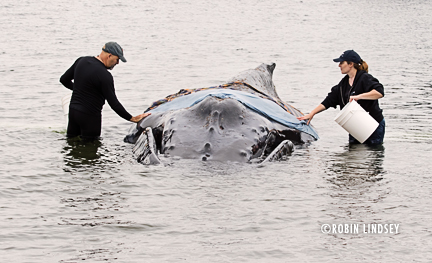
The fervent hope was that the animal was healthy enough to return to the Sound with the incoming tide many hours later - but breathing was already becoming less pronounced.
The Cascadia team, led by stranding coordinator Jessie Huggins, arrived along with Jeff Hogan, orca researcher and executive director of Killer Whale Tales. The two waded out into waist-deep water with buckets (photo above). They cautiously approached the whale, fully aware that one flick of the approximate 11-foot long, white pectoral fins or tail fluke could send them to the hospital, or worse. Due to their large size and the stressful situation they are in, live stranded whales pose a very real risk to First Responders.
Spreading sheets over the massive back, being careful that the blow hole was not covered so the whale could breathe, they then settled into a repetitive routine of pouring buckets of water to hydrate, pausing briefly in between to comfort the animal. They were joined in the water by MaST stranding team’s Kaddee Lawrence.
WDFW-MMI’s team, led by Dyanna Lambourn, was on site to assist with stranding response and necropsy, if necessary. Cascadia’s research scientist, John Calambokidis, made the drive from Olympia. John and NOAA Fisheries’ Lynne Barre fielded questions from the Seattle Times, West Seattle Blog, West Seattle Herald and every major local tv network.
Sadly, the efforts were in vain and the whale died at approximately 10:30am.
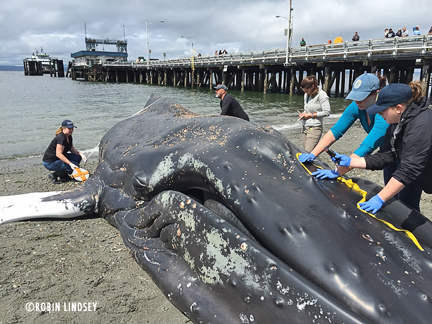
The first recorded humpback whale stranding in Puget Sound took place at the end of December, 2015. This juvenile would be the third stranding in less than a year (click here to find out the definition of a “stranding”). However, humpback sightings have increased in the Sound, so along with more sightings, comes the potential for more strandings. The biologists were intent on getting samples to see if there was any significant disease or contaminant trend.
Finally, after hours trying to deal with the complications - and expense - of towing and finding an appropriate site, it was decided the best option was to do a limited necropsy on the beach. The Cascadia and WDFW-MMI team worked quickly with an incoming tide, taking measurements, tissue, blood, fecal and blubber samples. Based on length, the female whale’s age was estimated as a juvenile, between 1.5 - 3 years old.
The whale was in poor body condition, with whale lice infestation and a parasite load in the intestinal tract. A weakened whale is an easy mark for harassment by transients orcas and there was evidence of orca rake wounds. For more details of the limited necropsy findings, visit Cascadia’s Facebook page.
Following the necropsy, the whale was towed by Washington State Ferry (WSF) workers and secured temporarily to the dock. On Tuesday morning, following a tow to an undisclosed location in the Sound, the carcass will be sunk and become a rich source of nourishment for varied marine life.
This terribly sad event was a well-choreographed team effort by many member groups of the Marine Mammal Stranding Network. We want to thank the homeowners, on whose beach the whale stranded, for their generosity throughout the day and evening. And special thanks to the WSF staff for their support on this challenging task and providing staff and vessels to move the whale.
Thanks to the volunteers who put in long hours yesterday, answering questions and keeping people back, enabling the biologists to do their work more efficiently. Seal Sitters volunteer Buzz Shaw, retired zoologist from the Seattle Aquarium, ended up with a unique keepsake. Upon arriving home last evening, he discovered the sheet he contributed to the cause was crawling with whale lice. Today, he managed to supply seven very happy teachers with whale lice for their classrooms and said, “It was a great way to make something positive out of a whale stranding and death.”
Many onlookers inquired how they can help. Local stranding networks can always use reliable volunteers (MMSN map of response areas here).
SEAL SITTERS NEW VOLUNTEER TRAINING WILL BE HELD ON AUGUST 27
Seal Sitters Marine Mammal Stranding Network responds to reports of all marine mammals along West Seattle shoreline. We will be holding our final volunteer training session for this season (the height of harbor seal pupping season in our area is September and October) on Saturday, August 27.
To learn more about the training and to RSVP, click here.
Harbor seal dies after apparent attack by large dog
Aug/02/16 05:47 AM
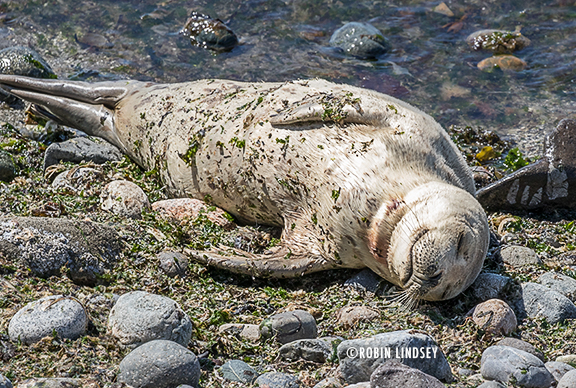
In a sad and disturbing turn of events, a juvenile harbor seal was the apparent victim of an attack by a large dog. Following rescue from a West Seattle beach by Seal Sitters MMSN, the seal died overnight at PAWS Wildlife Center on Wednesday, July 27.
The seal was reported resting at Constellation Park, also known as Charles Richey Viewpoint Park, late that morning (photo above). First Responders located the small animal near the sea wall and closed the ramp leading down to the beach. Tape and signs were strung along the metal railing above the pup to keep people from leaning over and scaring her back into the Sound. Undisrupted rest is crucial to survival.
When the light-coated seal rolled over onto her back, two distinctly parallel puncture wounds were noticed on the throat. Constellation is a notorious destination for people with off-leash dogs and First Responders were immediately suspicious. Photos were taken with a long telephoto lens and sent to a WDFW Marine Mammal Investigations Unit (WDFW-MMI) biologist for review. The wounds were confirmed consistent with attack by a canine. However, the seal returned to the water as high tide erased the beach she was resting on.
Several hours later, Seal Sitters’ dedicated hotline (206-905-7325) received a call from a homeowner who had a seal on her beach. She was concerned that people with off-leash dogs often accessed the beach at low tide.
The seal was lethargic, dehydrated and looked markedly thin. The neck wounds, viewed from a different angle, appeared terribly infected. Salt water can sometimes heal wounds, depending on location and severity. A text was sent to Seattle Aquarium veterinarian Dr. Lesanna Lahner. After a health consultation on the beach, she recommended immediate transport to PAWS for treatment. Since the injury was suspected to be inflicted by a domestic dog, the case was classified as human interaction and, therefore, an unnatural predation.
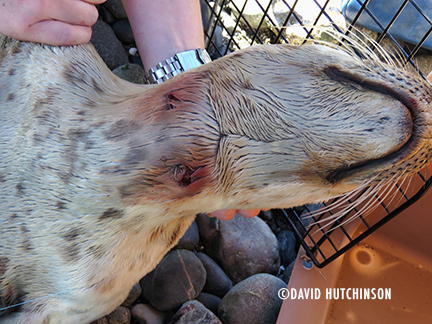
The wounds were consistent with those inflicted by a large dog - larger punctures and “less professional” than coyote bites. Since the attack was not witnessed (or at least reported) by anyone and the seal was found in an area known for off-leash dogs, the expert opinion was apparent predation by a large domestic canine. Tissue and blood samples have been sent out to a lab for analysis.
Upon exam, it was determined that the female seal was a juvenile and terribly thin, weighing only about 14kg (close to the birth weight of a seal pup).
Harbor seals are extremely vulnerable on land since, unlike sea lions, they can’t rotate their rear flippers for locomotion. Using only their front flippers, they move much like a caterpillar on the beach. Seals need to rest long hours out of Puget Sound’s frigid waters to warm up and gain the strength to forage. Unless close to the water’s edge, a seal - most especially, a very young, struggling or sleeping one - probably cannot escape a charging dog.
Countless times each year, Seal Sitters First Responders and our stranding network volunteers have conversations with people who have taken their dogs on the beach, illegal in Seattle Parks (read the ordinance here). A few are leashed, but the vast majority run free or chase after sticks and balls thrown into the water - on practically every beach in West Seattle. Often, the dogs can be seen on their own, exploring around the woody debris high up on the beach at Lincoln Park, where tired harbor seal pups sometimes will rest after a high tide.
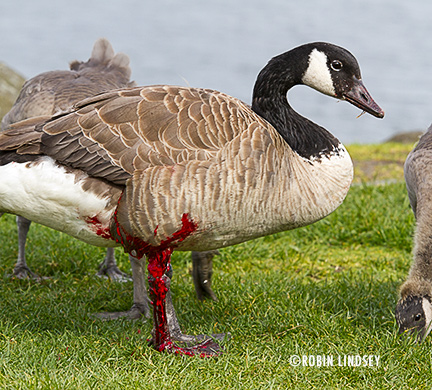
Dogs have a keen sense of smell and curiosity and instinctively chase other animals and birds. This includes the off-leash dog that viciously attacked an adult Canada Goose on the shore of Elliott Bay (at right, the bird survived after a lengthy rehab and was reunited with his mate and goslings). Or, the off-leash dog that injured one of Lincoln Park’s iconic and beloved white geese, who recovered.
Two years ago, there were a number of seal pups with suspect puncture wounds along West Seattle’s stretch of Puget Sound shoreline. Additionally, Seal Sitters has witnessed dogs that have chased seal pups back into the water, barely missing tearing into the rear flippers. Seals are protected from harassment and harm by the Marine Mammal Protection Act, violations of which are punishable by fine or imprisonment. NOAA recommends a distance of 100 yards from marine mammals whenever possible to avoid disturbance of their natural behavior.
“We’re so fortunate to live in a city that loves its animals, and we need to be responsible pet owners. Dogs are not allowed on Seattle beaches and must be kept on a leash in parks, except in designated off-leash areas,” said Brett Rogers, Seattle Animal Shelter regulatory compliance supervisor. “Owners who disregard the law are subject to various fines and penalties. Much more important than the financial disincentive, however, is safety. Not only do we need to be mindful of the needs of the wildlife that share our shores, our dogs rely on us to keep them safe from harm and from doing harm.”
All wildlife is in a daily struggle to survive, requiring many hours of foraging. They need stress-free rest, to conserve energy and recharge, as do all living things. A dog who disrupts this cycle can cause their decline and demise. Even worse, the dog who gets hold of wildlife can cause grave injury and death. There are certainly many, many attacks by off-leash dogs that go unknown or unreported. Enough is enough.
It is heartbreaking to think that this seal was terrorized by a domestic dog, one who should never have been on a beach. First seen at Constellation Park, the small seal was nicknamed Nova, which is the sudden brightness of a star.
Media, please click here for list of contacts for Seal Sitters, NOAA, PAWS, Seattle Animal Control and Seattle Aquarium veterinarian.
PLEASE NOTE:
We want to stress that Seal Sitters is by no means “anti-dog”. Many of us own and/or think the world of dogs. We are supportive of well-designed and conveniently located off-leash areas where dogs can get the exercise they need - safely, for both dogs and wildlife.
We ask all dog owners to be respectful and obey the common sense leash laws, so that everyone can enjoy the unique variety of wildlife that shares our neighborhoods and beaches.
It is now harbor seal pupping season and not unusual to find harbor seal pups resting on shore. Most often, a lone young seal will be a weaned pup or juvenile. A seal pup alone on shore that is still nursing age is usually the result of some kind of disturbance. The mom may abandon her pup if she feels it is not safe. Please stay back and call your local stranding network. In West Seattle, call Seal Sitters hotline @ 206-905-SEAL (7325).
To learn more about harbor seals and the work of NOAA’s Marine Mammal Stranding Network, please visit Seal Sitters’ website.







